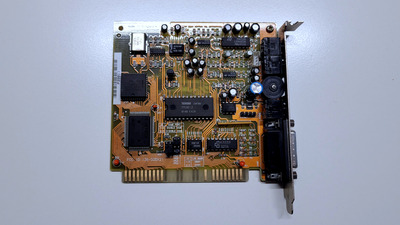First post, by appiah4
- Rank
- l33t++
For all the TLDR people out there: What kind of sound card is best for a 286 system for pre-1990 games?
And now, the wall of text:
I'm in the process of building a 286 PC. For the first time. And yes, I also think 286 is quite useless from a retro gaming point of view, but it is a piece of computer history I never used intimately and I want to get to know it better. This is what I did with Socket 754 for example, and now I am selling that system off (I came to the same conclusion that a very high end AGP system is dumb aside from being a novelty), I guess we'll see if this 286 sticks with me or not.
A little bit of personal history here: I got initiated on IBM PC-Compatibles in early '89 with our own first PC (which was IIRC an 8086, but I'll open another thread on that later today..). Coming from an ATARI 800XL, I was NOT impressed with it. AT ALL. Aside from Prince of Persia and BlockOut (both of which were mind blowingly good experiences) I found it to be a very lacklustre gaming machine. In less than a year it became my dad's office PC and an Amiga 500 (+512KB RAM) was bought as the home computer in late '89. Then in '93 that got replaced with a 486DX-33, so I basically skipped the entirety of the 286 era (although I had some experience with the 386DX on friends' computers). A lot of people at the time tried to convince me that their 286s were better than my Amiga, but I was not convinced until I saw Civilization running on a 286 in VGA in 1991. Now I'm trying to build my own 286 to see what I had missed.
The board I'm using for the build has an Am286-16 that can be de-turboed to 12MHz and onboard Multi-IO. I'll be using it with the onboard 1MB DIMM RAM which I think ought to be enough for this system, but I could go bonkers and replace them with up to 4MB with SIMMs if I want to. For video, I suppose any 256K+ ISA VGA card will do, even OTI's graphics decelerators and whatnot. However, for sound I am conflicted.
I experienced nearly the entire catalog of games from 1987-89 (and also 90, which may see play here to be honest) on an Amiga. I was SPOILED for sound, and I don't really know what options these games had on PC. I know that Sierra and Lucas games beyond a certain date had a lot of MT-32 support, but I have no idea when digital sound support started. So the questions in my mind are:
1a. Is an Adlib enough, or do I need a SB compatible card for digital sound?
1b. If yes, is OPL2/SB 2.0 compatible enough here or do I want to go with OPL3/Pro 2.0 compatible regardless?
2. I suppose an intelligent MIDI interface card is a no brainer considering SoftMPU won't run?
3. Do I want to try my luck with a PnP or Semi-PnP card or should I just stick to Non-PnP cards I have?
Thanks 😀
Retronautics: A digital gallery of my retro computers, hardware and projects.


